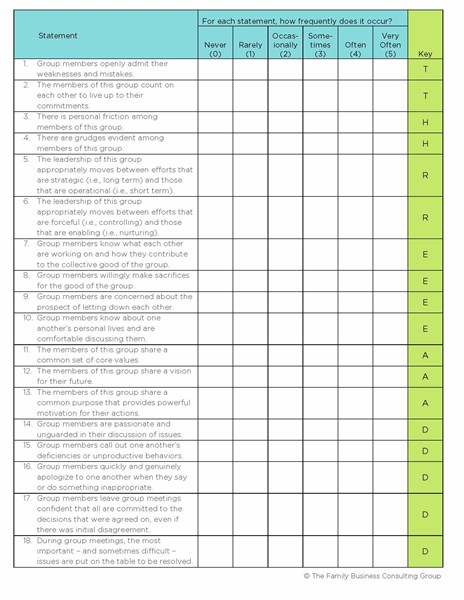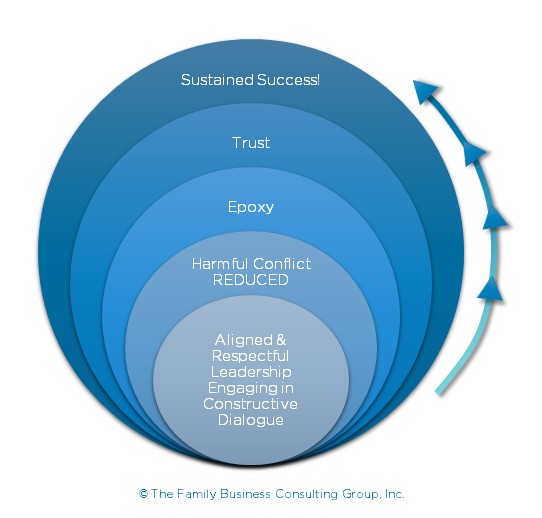An Uncommon Thread, Indeed
In any family business, there are many moving parts and therefore multiple different levers for its leaders to pull when it comes to guiding the family enterprise. Often, the factors that impact a family business’s success are out of the family’s control such as broad economic forces, political events, illness and just plain luck. However, there are factors that are within the control of a family business. Careful attention to those that matter most can better position a family business to succeed long term.
Fortunately, there is an “uncommon thread” that helps connect these varied moving parts together. This thread is uncommon because it is rare. This thread is also unique because unlike other types of thread, it is incredibly strong. Attending to and strengthening this thread can be difficult and not every family can do it. But those that prevail will have the opportunity to reap the tremendous reward of sustained success.
The following six elements are the fibers woven together to form the uncommon thread of family business success:
• Trust
• Halted Harmful Conflict
• Respectful Leadership
• Epoxy
• Alignment
• Dialogue that is Constructive
Trust among any group is essential because its presence leads to aligned interests and an increased likelihood that all will honor their commitments. Family businesses with a high level of trust are characterized by members who openly admit their weaknesses and mistakes, and they can count on each other to live up to their commitments.
Harmful Conflict exists when members have visible friction or hold grudges. Putting a halt to it (or at least working to minimize it) helps a family business to avoid those dangerous “elephants in the room” that can grow with time and distract the family business from the important issues.
Respectful Leadership is essential because a group without leadership can easily become aimless or, perhaps worse, devolve into separate factions that oppose each other. Leadership provides the necessary direction for any group, and respectful leadership exists when leaders are not oppressive or dictatorial, but instead balance control and nurturance of the group. These respectful leaders are most effective when they are able to move easily and appropriately between efforts that are focused on the long and short term. They also have the ability to be both strategic and tactical.
Epoxy refers to closeness or cohesion. Cohesive family businesses are characterized by members who know what is going on with each other (both professionally and personally), make sacrifices for each other and for the group as a whole, and don’t like to let the others down. Cohesive family businesses have members who are happy to be part of the family business. This closeness facilitates collaboration that ultimately impacts the family business in positive ways.
Alignment means that all individuals in a family business are on the same page and headed in the same direction. Alignment is exhibited by shared core values, a unified vision for the future, and a common purpose that provides all members with powerful motivation. Without alignment, family businesses run the risk of making limited progress, much like a boat that spins in circles because the rowers are paddling in different directions.
Dialogue that is constructive exists when family business members are passionate and unguarded in discussions, call out each other’s unproductive behaviors and quickly and genuinely apologize when appropriate. They are committed to group decisions (even if there was initial disagreement) and put the most important issues on the table. Constructive dialogue — as opposed to dialogue that is destructive — helps to prevent misunderstandings and confusion while moving the family business forward.
Assessing Your Family Business’s Thread
To strengthen your family business’s thread, the first step is to have each member of the family business provide their own perspective on the thread and identify its weak areas. To prevent the multitude of feedback from becoming unwieldy, below is a questionnaire to distribute to each family member. Compiling the answers will allow you to quickly discover those areas of the thread that require attention.
A few things to keep in mind when using the following assessment:
- The far right column labeled Key is for your use only as the administrator of this instrument. Remove this column before distributing the questions so that its presence does not create confusion for raters.
- The numbers in parentheses below each frequency descriptor (e.g., Never) are also for your use as assessment administrator. By tallying up the total points for each rater, you can have individual and group summary scores that indicate the strength of your family business’s thread. These scores do not mean much in isolation, but they do provide a valuable benchmark against which you can measure progress by re-administering the assessment in the future. Note: For the two items regarding Harmful Conflict, convert all points to negative numbers when scoring.
- This questionnaire also provides insight into the degree to which all participants are on the same page when it comes to assessing the family business. For example, if some individuals say that a certain behavior occurs only rarely while others say that it happens very often, it will be extremely valuable to have a group discussion to understand the reasons behind those different perceptions.

Click here for PDF version of questionnaire
How to Strengthen Your Family Business’s Thread
There are many specific strategies that can be used to address each element independently. For instance, trust is enhanced by similarity which means that one can increase trust with others by finding common ground based on shared interests. Or one can work specifically on reducing harmful conflict by committing to share concerns openly and non-judgmentally. A particularly good technique for doing so is the use of the age-old “I Statements.”
When working to strengthen your family business’s thread, it’s important to remember that the six elements are not only essential, but they are interrelated: trust is enhanced by cohesion; cohesion is strengthened through constructive dialogue; and cohesion, trust, and constructive dialogue all help to reduce harmful conflict.
More specifically, the relationship between the six elements looks like this:

As a result, improvement in one area will undoubtedly lead to improvements in other areas as well. Where you start is not nearly as important as simply starting. Pick an area and get to work. Doing so will create a ripple effect of improvement throughout your family business.
If you’re still unsure of where to begin, then begin at the core: ensure that your family business’s leadership is aligned and respectful while engaging in constructive dialogue. As a family business leader, how do you do that? Be sure that your leadership group is on the same page when it comes to values, vision, and purpose. You can also ensure your leadership group’s collective alignment by having a discussion in an open, authentic, and constructive way. If you do that while maintaining a balance between guidance and nurturance, you will encourage an environment within your family business that fosters sustained success.
Special thanks to Doug Breunlin, Rob Kaiser, and Patrick Lencioni, whose work contributed to the ideas in this article.

